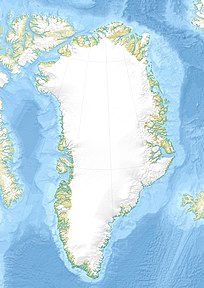Ikerasak
| Ikerasak (Sound) | ||
|---|---|---|
| Ikerasak | ||
| Commune | Avannaata Communia | |
| District | Uummannaq | |
| Geographical location | 70 ° 30 ′ 0 ″ N , 51 ° 18 ′ 0 ″ W | |
|
|
||
| Residents | 233 (January 1, 2020) |
|
| founding | 1822 | |
| Time zone | UTC-3 | |
Ikerasak [ iˈkɜʁasak ] (according to the old spelling Ikerasak ) is a settlement in Greenland in the Avannaata Kommunia in the Uummannaq district .
location
Ikerasak is located at the southeastern tip on an elongated island of the same name , about 36 kilometers west-southwest from the district capital Uummannaq . To the north flows the Ikinnguaq strait , which at Ikerasak is divided by the island of Qeqertarsuaq into the Ikerasannguaq and the Ikerasassuaq . On the other side of the Ikinnguaq is the Drygalski Halvø (Nunartarsuaq).
history
Ikerasak was already inhabited at the beginning of the colonial era. In 1793, 20 people lived in Ikerasak, 15 of whom were still unbaptized. In 1799 a house was built and the cook Svend Larsen began fishing for yarn in Ikerasak, in winter with the help of a sailor. In 1805 49 people lived in Ikerasak. Svend Larsen died in 1811 and the place was again only a Greenlandic dwelling place. In 1822 the place was named Udsted and Harald Christian Grundeitz became the first administrator of Udsted, which he remained until his death in 1866. It was extremely successful, often catching up to 1,300 seals a year. In 1849 65 people lived in Ikerasak.
In 1911 Ikerasak became a separate community in the colonial district of Uummannaq, to which the residential areas Uummannatsiaq and Qarajaq still belonged. In the past, Saattut and Akuliaruseq were assigned to the Udsted as living quarters. The parish was part of the 8th district of North Greenland and had a parish council with four members.
In 1915 there were already 110 people in Ikerasak, including a Dane. There were 17 Greenlandic houses, a Udsteds administrator's house from 1909, a dilapidated old house, a store with a stone packing house from 1854, a wooden provisions store from 1898, two cooper houses built as Greenlandic houses and three bacon houses from 1850, 1875 and 1909. The The church was a peat wall house from 1860, which was moved in 1903 and provided with a high wooden roof. It had, among other things, a sermon chair, a baptismal font, an altar and an altarpiece. There was also a 17 m² school building from 1860, which was also moved in 1903. A school chapel was built in 1937 and two packing houses in 1941 and 1945. Between 1930 and 1960 the population was fairly constant at around 100 people. But by 1970 it rose sharply to 269 inhabitants.
In 1950, Ikerasak became part of the new municipality of Uummannaq . During the administrative reform in 2009, the place was assigned to the Qaasuitsup Kommunia . Ikerasak has been part of Avannaata Kommunia since 2018 .
economy
Ikerasak lives from the fish ( halibut , sea wolf ), seal , whale , reindeer and musk ox hunting . The residents work as service providers, salespeople, teachers, carers or in the laundry, in old people's homes, in supply, administration or in tourism. The employment rate is 44%.
Infrastructure and supply
Ikerasak has two ports. One in the north for the fish factory and one in the middle for other boat and ship traffic. In the south of the settlement is the Ikerasak heliport . Otherwise, dog sleds and snowmobiles are used for transport. The roads are not paved, but rather loose paths.
Power is supplied by a power station, water is taken from Lake Kakisalik to the north and heated by oil stoves . There is no sewer system, but tanks whose contents are filled into the sea. Other rubbish ends up on the dump in the south. The Ole Løvstrømip Atuarfia school has 36 students.
Development
The old church was built in 1937, but defunctionalized in 1980. There are also two cemeteries: an old one and the one currently in use. There are several protected buildings in the village.
Sons and daughters
- Peter Fleischer (1904–1977), Provincial Councilor
- Jørgen Fleischer (1924–2012), journalist and writer
Population development
The population of Ikerasak is stable over the long term - sometimes increasing, sometimes decreasing.

Individual evidence
- ↑ Map with all official place names confirmed by Oqaasileriffik , provided by Asiaq
- ^ Alfred Bertelsen , Hother Ostermann : Beskrivelse af Distrikterne i Nordgrønland: Ũmánaĸ district. De grandson Bopladser. Ikerasak . In: Georg Carl Amdrup , Louis Bobé , Adolf Severin Jensen , Hans Peder Steensby (eds.): Grønland i tohundredeaaret for Hans Egedes landing (= Meddelelser om Grønland . Volume 60-61 ). tape 1 . C. A. Reitzel Boghandel, Copenhagen 1921, p. 407 ff . ( Digitized in the Internet Archive ).
- ↑ Jens Christian Madsen: Udsteder og bopladser i Grønland 1901-2000 . Atuagkat, 2009, ISBN 978-87-90133-76-4 , pp. 174 .
- ↑ a b c Ikerasak at qaasuitsup-kp.cowi.webhouse.dk
- ↑ Population of Ikerasak 1977–2020 at bank.stat.gl

